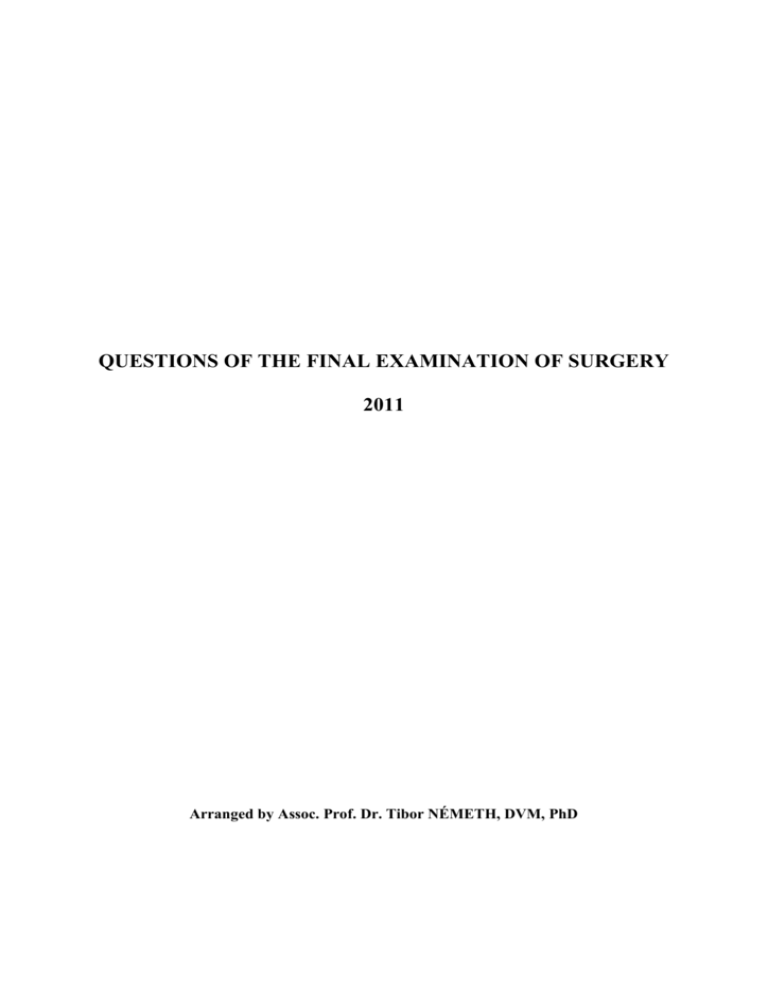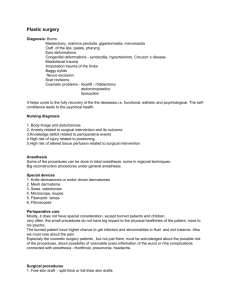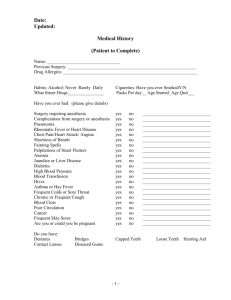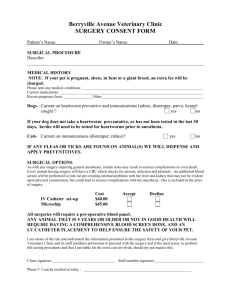QUESTIONS OF THE FINAL EXAMINATION OF SURGERY AND
advertisement

QUESTIONS OF THE FINAL EXAMINATION OF SURGERY 2011 Arranged by Assoc. Prof. Dr. Tibor NÉMETH, DVM, PhD Final examination of Surgery /2011/ English Dr.Németh QUESTIONS OF RADIOLOGY 1. Construction of diagnostic radiographic apparatus. Formation of X-ray 2. Features and effects of X-ray 3. Formation of X-ray picture; The X-ray cassette; intensifying screens;grid 4. Effect of ionisation radiation on organism. Protection from radiation 5. Radiography of the joints and bones. Bone tumours 6. Radiography of bone fractures 7. Metabolic bone diseases I. (hypertrophic osteodystrophy, renal osteodystrophy, hypervitaminosis A) 8. Metabolic bone diseases II. (panosteitis, secondary hyperparathyroidism, craniomandibular osteopathy, hypertrophic osteoarthropathy) 9. Radiography of osteochondritis dissecans 10. Radiography of elbow dysplasia 11. Radiography of hip dysplasia and aseptic femoral head and neck necrosis in small animals 12. Plain radiography of the vertebral coloumn 13. Myelography 14. Radiography of the head and the nasal cavity 15. Radiological anatomy of the thoracal cavity in dogs and cats 16. Radiography of the lungs and heart 17. Radiography of the esophagus and trachea 18. Radiological anatomy of the abdominal cavity in dogs and cats 19. Radiography of the gastrointestinal tract 20. Excretory urography. 21. Plain and contrast radiography of the urinary bladder and urethra 22. Features and application of contrast media 23. Radiology of the navicular region in horses 24. Radiography of the fetlock in horses 25. Radiography of the hoof and 2nd phalanx in horses 26. Radiographic changes in horses with laminitis 27. Radiography of the hock in horses 28. Radiography of the carpus in horses 29. Diagnostic imaging in the veterinary surgical diagnostics 2 Final examination of Surgery /2011/ English Dr.Németh QUESTIONS OF ANESTHESIOLOGY 1. Patient examination and preperation before anesthesia; ASA and CEPOD classifications 2. General anesthesia; premedication, induction, maintenance, recovery; stages of narcosis 3. Anticholinergs, phenothiazines, benzodiazepines 4. Alfa2-agonists, dissociative anesthetics 5. Propofol, steroid anesthetics, barbiturates 6. Opioids, neuroleptanalgesia, ataranalgesia 7. Halothane, isoflurane, sevoflurane 8. NSAID’s, local anesthetics, muscle relaxants 9. Construction and classification of anesthetic machines 10. Perioperative monitoring ; types and forms 11. Pulseoxymetry, capnometry 12. Characterisation of pain, significance of pain relief 13. Perioperative analgesia protocols 14. Anesthesia of low-risk-group small animal patients 15. Anesthesia of high-risk-group small animal patients: young and elderly age 16. Anesthesia of high-risk-group small animal patients: pregnancy 17. Anesthesia of high-risk-group small animal patients: cardiovascular disorders 18. Anesthesia of high-risk-group small animal patients: respiratory disorders 19. Anesthesia of high-risk-group small animal patients: hepatic and renal disorders 20. Anesthesia of high-risk-group small animal patients: GI and hormonal disorders 21. Anesthesia of high-risk-group small animal patients: septic state and trauma patients 22. Prevention of emergency, emergency drugs, antidotes, cardiopulmonal resuscitation 23. Sedation and local anesthesia of horses for procedures in standing position 24. Agents for premedication and induction of horses; intravenous anesthesia 25. Inhalational anesthesia of horses 26. Balance-anesthesia in equine practice 27. Anesthesia of swine 28. Anesthesia of ruminants (for surgery of the head, extremities and abdomen) 29. Anesthesia of high-risk-group equine patients: newborn and young foals, old horses 30. Anesthesia of high-risk-group equine patients: cases with ileus or trauma 3 Final examination of Surgery /2011/ English Dr.Németh QUESTIONS OF SURGICAL DIAGNOSTICS 1. Anamnesis and general examination of the surgical patient. Supplementary clinical examinations. 2. Regular and irregular conformation of the equine forelimb 3. Regular and irregular conformation of the equine hindlimb 4. Fundamentals of motion of the horse;character of the stride; arch of the foot flight; hoof mechanism; joint overextension 5. Classification (types, features) and degree of lameness in horses 6. Procedure of clinical examination of the lame horse 7. Examination of the thorax in small animals 8. Examination of the abdomen in small animals 9. Examination of the pelvis in small animals 10. Procedure of lameness diagnostics in small animals 11. Fundamentals of neurological examination in small animals 12. Intraarticular anesthesia of the equine forelimb 13. Intraarticular anesthesia of the equine hindlimb 14. Basic principles of diagnostic anesthesia of the horse 15. Perineural anesthesia of the equine forelimb 16. Examination of the fetlock, pastern and hoof in horses 17. Perineural anesthesia of the equine hindlimb 18. Examination of the equine metacarpal region, ultrasonographic anatomy 19. Examination of the forelimb in small animals 20. Examination of the hindlimb in small animals 21. Supplementary examination methods in lameness diagnostics 22. Provocation tests in equine lameness diagnostics 23. Examination of the circulatory system in colic horses 24. Examination of the alimentary system in colic horses 25. Diagnostic and therapeutic principals in colic horses 26. Diagnosis of shock 27. Emergency patient examination in small animals 28. Physical examination of the equine vertebral columne 4 Final examination of Surgery /2011/ English Dr.Németh QUESTIONS OF GENERAL SURGERY 1. Symptoms of fresh, aquired wounds 2. Classification of wounds and their symptoms 3. Process of wound healing. Clinical types of wound healing 4. Clinical appearance of first- and second-intention wound healing 5. Fundamentals of wound management. Clinical aspects of wounds of different origin 6. Abnormalities in wound healing 7. Types, local and systemic consequences of wound infection 8. Bite wound and its types 9. Punctured/stab and gunshot wound Diagnostics of penetrating/perforating wounds 10. Types and application of drainage 11. Surgical aspects of inflammation and the anti-inflammatory strategy 12. Closed mechanical injuries. Contusion, concussion 13. Necrosis. Fistulae 14. Surgical aspects of anti-inflammatory therapy 15. Phlegmone, abscess, edema, emphysema 16. Surgical aspects of antibiotic therapy 17. Opened joint injuries 18. Osteochondritis dissecans 19. Inflammation of the tendon sheath 20. Types, symptomes and healing process of bone fractures 21. Definition and classification of surgical operations. Preparation for surgery. Conditions of surgical intervention 22. Asepsis, antisepsis. Sterilisation. Disinfection 23. Definition, classification and symptoms of hernias 24. Conditions of bone and joint surgery 25. Basic considerations of bone and joint surgery 26. Evaluation of the equine body conformation 5 Final examination of Surgery /2011/ English Dr.Németh QUESTIONS OF DETAILED SURGERY 1. Clinical examination of the oral cavity in horses, tooth eruption, replacement of temporary teeth 2. Dental diseases in horses 3. Diseases of tooth-pulp in small animals 4. Dental alveolar diseases in small animals 5. Developmental abnormalities of the tooth and denture in small animals 6. Diseases of the paranasal sinuses in horses 7. Surgery of the oral cavity in small animals 8. Surgery of the pinna in small animals 9. Surgery of the external ear canal in small animals 10. Surgery of the pharyngeal region and salivary glands in small animals 11. Surgery of the upper airways in small animals 12. Fundamentals of thoracic surgery 13. Major diseases in thoracic surgery in small animals 14. Surgery of the esophagus in small animals 15. Equine umbilical hernia. 16. Equine abdominal wall herniation 17. Differential diagnosis of inguinal and scrotal hernias in stallions 18. Umbilical and inguinal hernia in small animals. 19. Traumatical abdominal hernia in small animals. 20. Perineal hernia 21. Surgery of the diaphragmatic hernia in small animals 22. Intestinal obstruction in the horse 23. Surgical diseases of the alimentary system of the cattle 24. General aspects of laparotomy in small animals 25. Surgery of the stomach in small animals 26. Ethiology, pathogenesis, signs and therapy of small intestinal obstruction in small animals 27. Types and differential diagnostics of small intestinal obstruction in small animals 28. Surgery of the small intestine in small animals 29. Surgery of the anorectum in small animals 30. Surgery of the liver and the spleen in small animals 31. Castration and its surgical complications in horses 32. Cryptorchidism in horses 6 Final examination of Surgery /2011/ English Dr.Németh 33. Diseases of the penis in stallions (phimosis, paraphimosis, paralysis of the penis) 34. Surgery of the kidney and ureter in small animals 35. Surgery of the urinary bladder in small animals 36. Surgery of the urethra in small animals 37. Feline Lower Urinary Tract Disease (FLUTD) 38. Surgery of the prostate gland in small animals. 39. Cryptorchidism;castration in small animals 40. Surgical aspects of acute abdomen 41. Fundamentals and steps of lameness diagnostics in horses 42. Treatment possibilities of acute and chronic tendonitis in horses 43. Pathogenesis of tendonitis in horses 44. Rupture of the suspensory ligament, DDFT, SDFT and peroneus tertius 45. Condenital flexure deformities in the newborn foal 46. Acquired flexure deformities in horses 47. Fracture of the proximal, middle and distal phalanx in horses 48. Injuries of the coronary region, basic therapeutic principles 49. Cellulitis; elephantiasis 50. Injuries of the hoof wall, hoof cracks 51. Bruise, corns, gravel, trush, cancer. 52. Penetrating wounds of the hoof. Septic laminitis. 53. Laminitis in horses 54. Navicular disease 55. Irregular clows in cattles. Clows management in cattles 56. Specific traumatic ulceration of the bovine claws 57. Indications and surgical procedure of claw amputation in the cattle 58. Disease of the claws in swine 59. Diseases of the claws in sheep. Panaritium in sheep 60. Therapeutic considerations of open fractures in small animals 61. Therapeutic considerations of open fractures in horses 62. Crib biting, wind sucking in the horse; therapeutic principles 63. Amputation of the horn in cattle 64. Most frequent diseases of the upper airways and their surgical treatment in horses 65. Diseases of bursae in horses 66. Degenerative joint disease in the horse. 67. Diseases of the elbow in small animals 7 Final examination of Surgery /2011/ English Dr.Németh 68. Diseases of the shoulder joint in small animals 69. Diseases of the hip joint in small animals 70. Diseases of the stifle joint in small animals 71. Diseases of the carpus and tarsus in small animals 72. Methods of operative fixation of bone fractures 8








